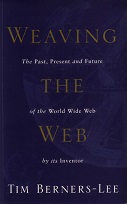Review of 'Weaving the Web'
Weaving the Web by Tim Berners-Lee
 Tim Berners-Lee is often called the creator of the Internet but this is, in fact, incorrect. He is instead the creator of the World Wide Web system we use to navigate the Internet for example via a browser. He created the addressing protocol used and HTML which is used for creating web pages. In “Weaving the Web” Berners-Lee talks of the original system he created while working at CERN to store information he found helpful. This was a simple system he called “Enquire” which allowed him to link to resources no matter where or how they were stored. Up until then the Internet was governed by a mix-mash of technologies and isolated file formats making retrieval of content between systems incredibly difficult. Berners-Lee saw the need to standardise access to these resources and so took it upon himself to do so. As people became interested in what he was doing he soon realised he would not be able to do this on his own and started recruiting people to help in his effort culminating in what we now know as the World Wide Web Consortium (W3C) which does not publish standards but rather recommendations to facilitate the World Wide Web. Early on Berners-Lee tells of his exhaustion with discussions about this new technology which digressed into arguments about some minor aspect. He is still very much of the opinion that rules should be kept to a bare minimum and then only to enforce the fundamentals required for the web.
Tim Berners-Lee is often called the creator of the Internet but this is, in fact, incorrect. He is instead the creator of the World Wide Web system we use to navigate the Internet for example via a browser. He created the addressing protocol used and HTML which is used for creating web pages. In “Weaving the Web” Berners-Lee talks of the original system he created while working at CERN to store information he found helpful. This was a simple system he called “Enquire” which allowed him to link to resources no matter where or how they were stored. Up until then the Internet was governed by a mix-mash of technologies and isolated file formats making retrieval of content between systems incredibly difficult. Berners-Lee saw the need to standardise access to these resources and so took it upon himself to do so. As people became interested in what he was doing he soon realised he would not be able to do this on his own and started recruiting people to help in his effort culminating in what we now know as the World Wide Web Consortium (W3C) which does not publish standards but rather recommendations to facilitate the World Wide Web. Early on Berners-Lee tells of his exhaustion with discussions about this new technology which digressed into arguments about some minor aspect. He is still very much of the opinion that rules should be kept to a bare minimum and then only to enforce the fundamentals required for the web.
Berners-Lee even at an early date recognized various needs of the web we still struggle with today: Privacy, porn, and the rise of machine learning. Indeed, the very structure of the web is based on a “knowledge graph”, a fundamental part of machine learning or “AI” (the company I work for is involved in the “Semantic Web” so it is a topic I have a personal interest in).
Though this book is a bit dated (Google is not even mentioned!), it does provide an interesting insight into the founding of the World Wide Web. Perhaps only of interest to computer and Internet geeks it does not stray too much into technical detail. The philosophical reasoning and thoughts behind the web are incredibly insightful for the technology that is now so ubiquitous. I did find the book a bit slow in parts but it is not really long enough to bore too much.
An appendix has a copy of Berners-Lee's original “Information Management” proposal for CERN followed by a glossary of terms.
Rating: “Nearly perfect, but not quite”
Review Date: 2023-02-26
Genre: Non-Fiction
Publisher: Texere
Publication Date: 2000
ISBN: 1587990180